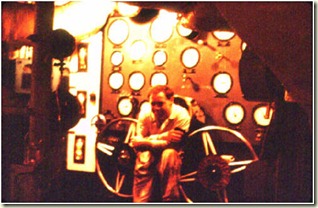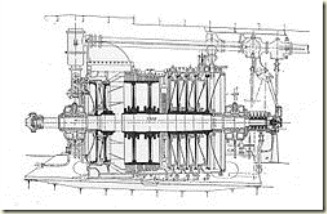Now where was I………………………………..?
Oh yes I was in the boiler room. It has been pointed out in the comments that I haven’t given a good description of the properties of superheated steam. Most of us think of steam as the wispy stuff emanating from the spout of the kettle. Wrong. The wispy bit is actually water vapour condensing from steam. It’s the bit you can’t see close to the spout that is steam.
Pure steam is a transparent gas. At standard temperature and pressure, pure steam (unmixed with air, but in equilibrium with liquid water) occupies about 1,600 times the volume of an equal mass of liquid water. In the atmosphere, the partial pressure of water is much lower than 1 atm, therefore gaseous water can exist at temperatures much lower than 100 °C (212 °F) (see water vapour and humidity).
In the above paragraph you’ll note that you can’t see real steam.
The one thing that may save your life is your hearing. Superheated steam at 600 psi (41 bar) and at a temperature of 800 deg F (426 deg C), makes a noise when it is issuing from a small hole or leaking gland. As I said in my last post don’t believe that noise is a drunken motorman whistling. Another valuable aid involves a piece of stick and a captured sea gull. *Now you really think I’m losing my marbles* It’s really quite simple. Take one feather, attach it to the stick, hold stick in front of you, and when the feather magically disappears you know the rough vicinity of the steam leak.
Technical bit over for now.
Damn. Lost my train of thought.
Anyway the ship set sail for an exotic location. So I thought. I was wrong. Instead we sail across the Indian Ocean till we nearly hit Africa. Then we stopped. What was our purpose you ask? We were to maintain a blockade of the Rhodesian (Zimbabwe) port of Beira to stop the import of fuel to the then, white Government of Ian Smith who had declared unilateral independence.
All in all we spent months of that coast. Sometimes at a crawl up the coast, sometimes drifting, even sometimes going in large circles just to break the monotony. Occasionally we would meet up with other ships in the task force and competitive sports would be played. deck Hockey being one of them. All to win that most coveted prize. “The Beira Bucket” (Mentioned in my last post).
The trophy for these sporting activities was a battered old metal bucket which at the end of each sporting contest was hung triumphantly from the winning ship’s yardarm. Now housed in the Portsmouth Naval Museum it remains as a reminder to crews and naval personnel of those Indian Ocean patrols in the years 1966 to 1971.
Decorated with ships names and crests, the bent and battered Beira Bucket is an unusual reminder of those years in the Mozambique Channel, and has been the subject of a number of fond reunions in the past years.
After months of patrol I would happily have kicked the sodding thing over the side.
*Technical stuff alert*. Look away now if you hate technology.
The one thing that I had plenty of time do though, was to actually find out how all this strange machinery worked. Right we’ve had the steam in all it’s forms bit so I’ll give you and idea what to do with it. First it would meander it’s way through large, lagged pipes until it arrived at the throttles in the engine room. (Think huge tap) . The two throttles, one for forward and one for backwards (Even ships need a reverse gear. Especially if someone shouts out “Iceberg ahead”), were controlled by what looked like large steering wheels.
An actual picture of the control station of The Tidereach
The steam (superheated type) would then whiz over and into the turbine which is made up of steam injection nozzles and rows and rows of rings with blades on them. Pretty much the same as a modern jet engine.
Of course this turbine would spin at several thousand RPM which is not a very practical speed to turn a ships propeller. A bit akin to permanent wheel spin. So just like a car you need a gearbox to achieve an output speed somewhere in the region of 100 RPM.
Whilst all this is going on all that steam wizzing out of the boilers causes the water levels to drop therefore it needs to be replenished. This is where those handy little items, condensers and feed pumps come in. The steam leaving the turbine is no longer superheated, as it has given up much of it’s energy to produce motion, and is now a saturated vapour. This vapour is cooled in the condenser by sea water(Plenty of that. The volume of the oceans and their seas is nearly 1.5 × 109 [sic] cubic kilometers"), and then pumped back into the boilers.
Now you know as much as me about steam engineering. After all I’m qualified as a Motor Engineer.
Are you bored yet?
Next time on Lost Fe’s adventures at sea will be Sembewang, voyage on a destroyer, a broken light bulb (You think I’m joking. Oh No), Japan, and Ladies of the night, and Portland harbour.
Mind you I might just blog about the local elections or the Royal wedding. Your choice. You have been warned. Don’t blame me if it ends in tears.


The only tears which this highly entertaining saga is likely to end in, are tears of laughter .. As I fondly recall a thoroughly mis-spent youth in the "Far Flung" ..
ReplyDeleteCrack-on FE ...
Blog about the Royal friggin wedding and I'm off. Your past life is far more entertaining.
ReplyDeleteThe Royal wedding, Part one.
ReplyDeleteCatchy little heading.
C'mon FE, stop teasing.
ReplyDeleteYour readership has nominated me to ask when are you going to get to 'the juicy bits'?
OK - I'll be the boring old fart and ask yet another technical question:
ReplyDelete"The two throttles, one for forward and one for backwards"
As far as I'm aware turbines only work in one direction, due to the angle of the blades and guide vanes, does this therefore mean that a second turbine was required for reverse?
Or did they have variable pitch blades/vanes?
Yeah, what he says above, enjoying it.
ReplyDelete"Full Ahead, both" Shippers .. :)
ReplyDeleteAnother excellent, fascinating read :-)
ReplyDeleteMD.
ReplyDeleteYes there are two turbines. A big one for forwards and a smaller one for backwards.
The best instruction I ever heard whilst on a steam-turbine tanker was from the Chief Engineer.
ReplyDeleteHe said "If you hear a steam leak from around the turbine or piping, the only thing you need is a sheet of paper. You walk forward, very slowly waving the paper in front as you move. When the paper is suddenly sliced in half; you have located the source of the leak. Shut-down and repair time is then permitted!"
Mike. That's what turned me to the dark side. Ie. Motor. I refused to be cut in half by a vapour I couldn't see.
ReplyDeleteWhat dress uniforms and work clothes did you wear, please? I'm just looking at Dudley Jarrett's 1960 history of British Naval dress but it stops at 1960.
ReplyDeleteWOAR.
ReplyDeleteOur main uniform was a reefer jacket with rank in gold lace on the sleeves.
Working dress was a white boiler suit.
Since then a lot more uniforms for various occasions have been added.
I could probably do a whole post on them.